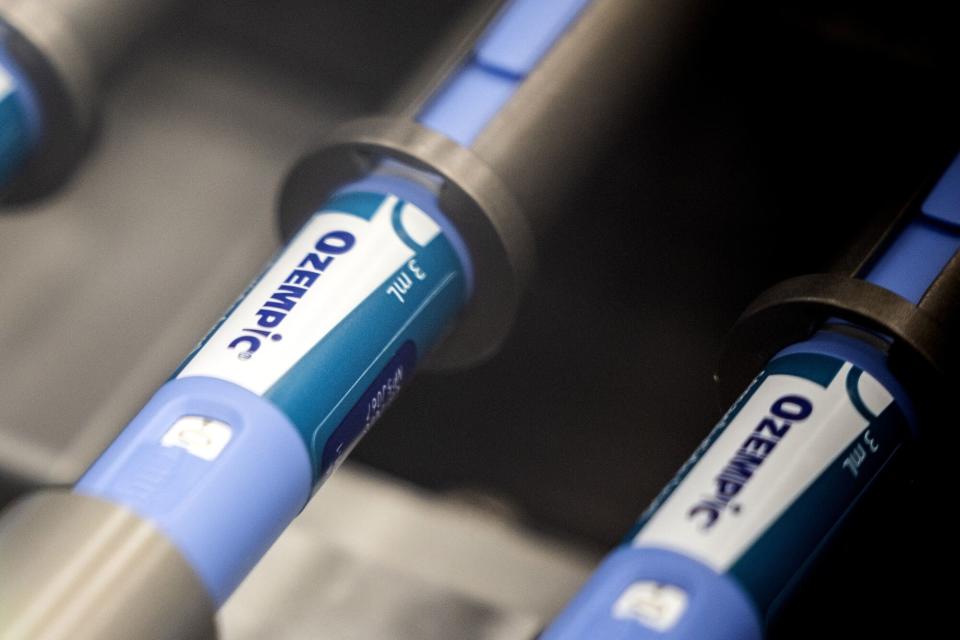Ozempic Linked to Rare Cases of Vision Loss in Harvard Study

(Bloomberg) — Novo Nordisk A/S’ (NVO) best-selling diabetes and weight-loss drugs Ozempic and Wegovy appear to be associated with a higher risk of a rare form of vision loss, according to an analysis by doctors at Massachusetts Eye and Ear, a Harvard-affiliated hospital.
Most Read from Bloomberg
China Can End Russia’s War in Ukraine With One Phone Call, Finland Says
Biden Struggles to Contain Pressure to Abandon Reelection Bid
Patients who took the drugs for weight loss were more than seven times more likely to be diagnosed with a stroke-like eye condition, known as NAION, than those taking other classes of drugs for obesity, according to the study of patient records. Those taking the drugs for diabetes were more than four times more likely to develop the rare ailment than people on other types of treatments, according to the results published Wednesday in the journal JAMA Ophthalmology.
The relatively small study examined the records of Massachusetts Eye and Ear patients. The low number of cases of the eye condition in people who took the drugs — 37 between both groups — limited the study’s statistical power, according to the paper. The findings don’t prove the medications caused the eye complication and must be replicated in larger studies involving more hospitals, the Harvard researchers and other experts said.
“I don’t think this is a strong enough signal to take patients off the drug,” said Susan Mollan, a neuro-ophthalmologist in Birmingham, England, who wrote an editorial accompanying the study. It didn’t show that the eye effect immediately followed taking the drugs, as some of the cases occurred months later. Still, doctors should tell patients about the potential risk, she said.
The incredible popularity of Novo and rival Eli Lilly & Co.’s (LLY) weight-loss drugs has caused shortages that both companies have worked to rectify. Novo’s semaglutide, the active ingredient in Ozempic and Wegovy, has been studied for more than 15 years and scientists largely consider it safe. But as the drugs are used by more people, researchers are looking to see if there are any previously unknown side effects emerging.
“Patient safety is a top priority for Novo Nordisk, and we take all reports about adverse events from use of our medicines very seriously,” a Novo spokesperson said in an emailed statement. The Harvard study had some key limitations, the spokesperson said, and other large, real-world studies provide reassurance that the drugs are safe. NAION isn’t among the adverse reactions listed on the two drugs’ labels, they said.

Careful Look
The Mass Eye and Ear analysis was designed to look at whether semaglutide is associated with increased risk of NAION after doctors noticed a handful of cases and realized those patients were on the drug. The condition normally affects between one in 10,000 and one in 50,000 people per year, and usually leads to permanent partial vision loss in the affected eye. There’s no standard treatment.
This potential risk “is something that definitely should be looked at more carefully,” said Mahyar Etminan, a drug safety researcher at the University of British Columbia in Vancouver, who wasn’t involved in the study. “This is a very serious condition so if it were true, it changes the risk-benefit calculus.”
That’s particularly relevant for people taking Wegovy only for weight loss and don’t have other medical conditions that could benefit from treatment, he added.
Hard to Know
There are other reasons that make it important to follow up on the study, Etminan said. Diabetes itself is a risk factor for the eye condition, he pointed out, so it’s unclear how Ozempic or Wegovy would cause it. The design of the study makes it hard to know whether it was the severity of their diabetes or heart disease that raised patients’ risk, rather than taking the drugs, he said.
The study included 710 patients prescribed diabetes drugs and 979 patients prescribed weight-loss drugs who were treated at Mass Eye and Ear over a six-year period starting in December 2017, when Ozempic was first approved. Within those two groups, the researchers compared the rates of NAION in people who had filled their first prescriptions for Ozempic or Wegovy to the rates of those on rival treatments. They didn’t look at Mounjaro and Zepbound, the diabetes and obesity treatments made by Lilly.
The researchers started the study last summer after three people came into the clinic with NAION over a short period of time, all who were on semaglutide, said Joseph Rizzo, director of the neuro-ophthalmology service at Mass Eye and Ear and a Harvard Medical School professor.
Now his group is talking with other researchers about performing a much larger study involving other hospitals.
“My hope is that doctors and patients are aware of this association,” he said, while emphasizing that the study doesn’t prove a causal link between the drug and the eye disease. It’s particularly important for patients who already have some vision loss to know about the possible risk so they can make an informed decision before starting it, he said.
(Updates shares in sixth paragraph, Novo comment in seventh.)
Most Read from Bloomberg Businessweek
China’s Investment Bankers Join the Communist Party as Morale (and Paychecks) Shrink
The Fried Chicken Sandwich Wars Are More Cutthroat Than Ever Before
Dragons and Sex Are Now a $610 Million Business Sweeping Publishing
For Tesla, a Smaller Drop in Sales Is Something to Celebrate
©2024 Bloomberg L.P.

 Yahoo Finance
Yahoo Finance 